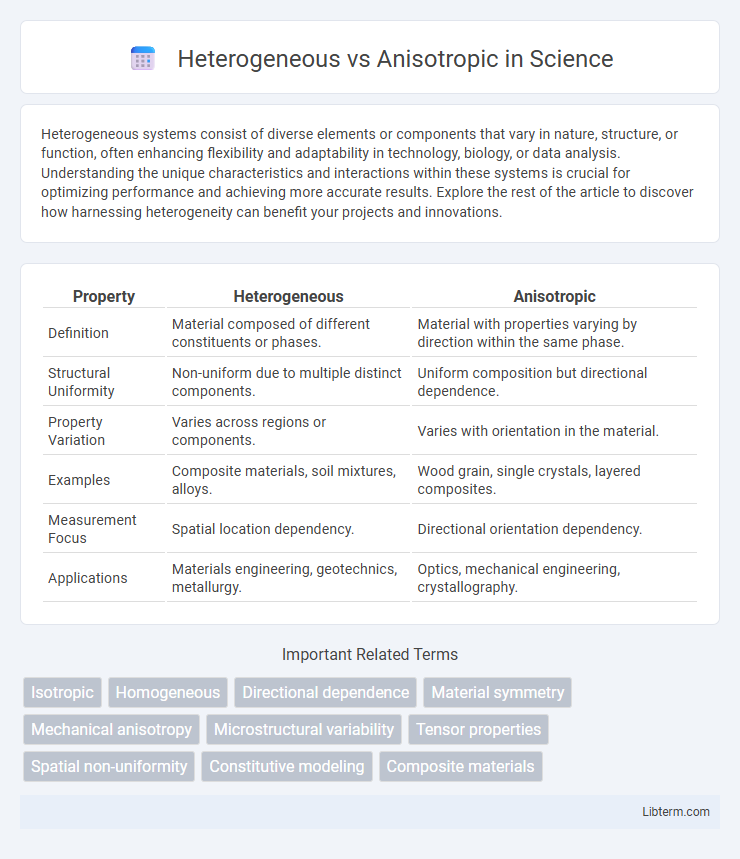Heterogeneous systems consist of diverse elements or components that vary in nature, structure, or function, often enhancing flexibility and adaptability in technology, biology, or data analysis. Understanding the unique characteristics and interactions within these systems is crucial for optimizing performance and achieving more accurate results. Explore the rest of the article to discover how harnessing heterogeneity can benefit your projects and innovations.
Table of Comparison
| Property | Heterogeneous | Anisotropic |
|---|---|---|
| Definition | Material composed of different constituents or phases. | Material with properties varying by direction within the same phase. |
| Structural Uniformity | Non-uniform due to multiple distinct components. | Uniform composition but directional dependence. |
| Property Variation | Varies across regions or components. | Varies with orientation in the material. |
| Examples | Composite materials, soil mixtures, alloys. | Wood grain, single crystals, layered composites. |
| Measurement Focus | Spatial location dependency. | Directional orientation dependency. |
| Applications | Materials engineering, geotechnics, metallurgy. | Optics, mechanical engineering, crystallography. |
Introduction to Material Properties
Heterogeneous materials consist of different components or phases with distinct properties distributed unevenly throughout the structure, affecting overall material behavior. Anisotropic materials exhibit direction-dependent properties, where mechanical or physical characteristics vary based on orientation within the material. Understanding the contrast between heterogeneity and anisotropy is essential for predicting material performance in engineering and materials science applications.
Defining Heterogeneous Materials
Heterogeneous materials consist of multiple distinct phases or components with different physical or chemical properties, leading to non-uniform composition and structure throughout the material. These variations result in spatial differences in mechanical, thermal, or electrical behavior, which are measurable at different points within the material. Unlike anisotropic materials, which have direction-dependent properties but uniform composition, heterogeneous materials exhibit property changes due to the presence of distinct constituents or phases.
Understanding Anisotropic Materials
Anisotropic materials exhibit direction-dependent properties, meaning their mechanical, thermal, or electrical characteristics vary based on the orientation of measurement. Unlike heterogeneous materials, which consist of different components or phases, anisotropic behavior arises from the internal structure or molecular alignment within a single material. Understanding anisotropic materials is crucial in applications like composite manufacturing, where fiber orientation significantly influences strength and conductivity.
Key Differences: Heterogeneous vs Anisotropic
Heterogeneous materials exhibit variations in composition or structure across their volume, resulting in non-uniform properties, while anisotropic materials have direction-dependent properties despite uniform composition. The key difference lies in heterogeneity referring to spatial variability in constituents, whereas anisotropy pertains to directional dependence of physical or mechanical behavior. Understanding these distinctions is crucial in fields like material science, geology, and engineering for accurate analysis and application.
Examples of Heterogeneous Materials
Heterogeneous materials consist of distinct components or phases that are unevenly distributed, such as concrete, wood, and granite. Concrete includes aggregate particles embedded in a cement matrix, wood features cellulose fibers distributed within a lignin matrix, and granite is composed of interlocking mineral crystals like quartz, feldspar, and mica. These materials display different physical or chemical properties in various regions, contrasting with anisotropic materials that exhibit direction-dependent properties due to internal structure.
Examples of Anisotropic Materials
Anisotropic materials exhibit direction-dependent properties, meaning their mechanical, thermal, or optical characteristics vary based on orientation. Common examples include wood, which is stronger along the grain than across it, and graphite, where electrical conductivity is high within layers but low perpendicular to them. Composite materials like carbon fiber reinforced polymers also demonstrate anisotropy due to the alignment of fibers, enhancing strength and stiffness in specific directions.
Applications in Engineering and Science
Heterogeneous materials contain multiple distinct phases or components, significantly influencing their use in composite structures and biological tissue modeling, where varying properties at different locations affect performance. Anisotropic materials exhibit directional dependence in their mechanical, thermal, or electrical properties, crucial in applications such as aerospace engineering for stress analysis and in geophysics for seismic wave propagation studies. Advanced engineering designs leverage heterogeneous and anisotropic characteristics to optimize material strength, durability, and functionality across sectors like automotive manufacturing, civil infrastructure, and materials science.
Methods for Identifying Material Properties
Methods for identifying heterogeneous material properties often involve spatially resolved techniques such as digital image correlation (DIC), X-ray computed tomography (XCT), and micro-indentation mapping to capture variability across samples. Anisotropic materials require directional testing methods including ultrasonic velocity analysis, polarized light microscopy, and tensor-based mechanical testing to quantify property variations along different axes. Computational approaches, such as inverse finite element analysis and machine learning models, further enhance the accuracy of characterizing complex heterogeneous and anisotropic behaviors.
Impact on Material Performance
Heterogeneous materials exhibit variations in composition or structure throughout their volume, leading to localized differences in mechanical properties that can cause stress concentrations and affect durability. Anisotropic materials display direction-dependent properties, influencing stiffness, strength, and thermal expansion along different axes, which optimizes performance for specific loading conditions. Understanding the interplay between heterogeneity and anisotropy is critical for engineering materials tailored to applications requiring precise mechanical behavior and reliability.
Conclusion: Choosing the Right Material
Selecting the right material depends on the specific application requirements, where heterogeneous materials offer varied properties due to their non-uniform composition, while anisotropic materials exhibit direction-dependent characteristics essential for tailored performance. Understanding the operational environment and mechanical demands ensures optimal use of heterogeneous composites for versatility or anisotropic substances for directional strength. Advanced material engineering leverages these differences to enhance functionality in aerospace, biomedical implants, and structural components.
Heterogeneous Infographic

 libterm.com
libterm.com